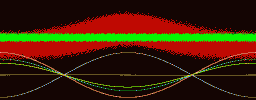Alfvén wave
File:Observations Reshape Basic Plasma Wave Physics.webm
Alfvén waves are a type of magnetohydrodynamic wave (MHD wave) that occurs in a plasma. These waves were first proposed by the Swedish physicist Hannes Alfvén in 1942, for which he later received the Nobel Prize in Physics in 1970. Alfvén waves play a crucial role in the dynamics of astrophysical, space, and laboratory plasmas. They are characterized by the propagation of magnetic field oscillations along the direction of the ambient magnetic field, coupled with the motion of the plasma medium.
Properties and Characteristics[edit | edit source]
Alfvén waves are transverse in nature, meaning that the displacement of the plasma and the perturbations of the magnetic field occur perpendicular to the direction of wave propagation. These waves can travel along magnetic field lines at the Alfvén speed, \(v_A\), which is determined by the magnetic field strength and the density of the plasma. The Alfvén speed is given by the formula:
\[v_A = \frac{B}{\sqrt{\mu_0 \rho}}\]
where \(B\) is the magnetic field strength, \(\mu_0\) is the magnetic permeability of free space, and \(\rho\) is the mass density of the plasma.
Types of Alfvén Waves[edit | edit source]
There are two main types of Alfvén waves: shear Alfvén waves and compressional Alfvén waves. Shear Alfvén waves involve oscillations that are strictly perpendicular to both the magnetic field and the direction of wave propagation, without any compression of the plasma. Compressional Alfvén waves, on the other hand, can propagate in a direction oblique to the magnetic field and involve variations in the plasma density and magnetic field magnitude.
Applications and Importance[edit | edit source]
Alfvén waves have significant implications in various fields of physics and astronomy. In solar physics, they are believed to play a key role in the heating of the solar corona and the acceleration of the solar wind. In astrophysics, Alfvén waves are involved in the dynamics of stellar winds, accretion disks around black holes, and the interstellar medium. Understanding Alfvén waves is also crucial for fusion energy research, particularly in the context of magnetic confinement fusion devices like tokamaks and stellarators, where they can influence plasma stability and heat transport.
Observations and Experiments[edit | edit source]
Alfvén waves have been observed in various environments, from laboratory plasmas to the solar atmosphere and the interstellar medium. In the solar context, observations from spacecraft such as the Solar Dynamics Observatory (SDO) and missions like Parker Solar Probe and Solar Orbiter have provided valuable insights into how Alfvén waves contribute to solar phenomena. Laboratory experiments, often using devices like the Large Plasma Device (LAPD) at the UCLA Plasma Science and Technology Institute, have been instrumental in studying the fundamental properties of Alfvén waves under controlled conditions.
Challenges and Future Directions[edit | edit source]
One of the challenges in Alfvén wave research is accurately measuring these waves in both space and laboratory environments, due to their often small amplitudes and the complex dynamics of plasma environments. Future research aims to further understand the role of Alfvén waves in plasma heating and acceleration processes, their interaction with other types of waves and instabilities, and their potential applications in energy and propulsion systems.
Search WikiMD
Ad.Tired of being Overweight? Try W8MD's physician weight loss program.
Semaglutide (Ozempic / Wegovy and Tirzepatide (Mounjaro / Zepbound) available.
Advertise on WikiMD
|
WikiMD's Wellness Encyclopedia |
| Let Food Be Thy Medicine Medicine Thy Food - Hippocrates |
Translate this page: - East Asian
中文,
日本,
한국어,
South Asian
हिन्दी,
தமிழ்,
తెలుగు,
Urdu,
ಕನ್ನಡ,
Southeast Asian
Indonesian,
Vietnamese,
Thai,
မြန်မာဘာသာ,
বাংলা
European
español,
Deutsch,
français,
Greek,
português do Brasil,
polski,
română,
русский,
Nederlands,
norsk,
svenska,
suomi,
Italian
Middle Eastern & African
عربى,
Turkish,
Persian,
Hebrew,
Afrikaans,
isiZulu,
Kiswahili,
Other
Bulgarian,
Hungarian,
Czech,
Swedish,
മലയാളം,
मराठी,
ਪੰਜਾਬੀ,
ગુજરાતી,
Portuguese,
Ukrainian
Medical Disclaimer: WikiMD is not a substitute for professional medical advice. The information on WikiMD is provided as an information resource only, may be incorrect, outdated or misleading, and is not to be used or relied on for any diagnostic or treatment purposes. Please consult your health care provider before making any healthcare decisions or for guidance about a specific medical condition. WikiMD expressly disclaims responsibility, and shall have no liability, for any damages, loss, injury, or liability whatsoever suffered as a result of your reliance on the information contained in this site. By visiting this site you agree to the foregoing terms and conditions, which may from time to time be changed or supplemented by WikiMD. If you do not agree to the foregoing terms and conditions, you should not enter or use this site. See full disclaimer.
Credits:Most images are courtesy of Wikimedia commons, and templates Wikipedia, licensed under CC BY SA or similar.
Contributors: Prab R. Tumpati, MD


